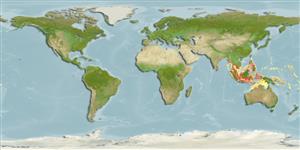Elasmobranchii (tubarões e raias) (sharks and rays) >
Myliobatiformes (Stingrays) >
Dasyatidae (Stingrays) > Urogymninae
Etymology: Himantura: Greek, iman, imantos = thong, strap + Greek, oura = tail (Ref. 45335).
Environment: milieu / climate zone / depth range / distribution range
Ecologia
marinhas demersal. Tropical
Indo-Pacific: off India, Indonesia, and Gulf of Thailand.
Tamanho / Peso / Idade
Maturity: Lm ? range ? - ? cm
Max length : 120 cm WD macho/indeterminado; (Ref. 58048)
Descrição breve
Chaves de identificação | Morfologia | Morfometria
This species is characterized by absence of skin fold on the ventral surface of the tail; quadrangular profile of disc; whip-like tail variably banded; adults' upper surface with widely spaced, honeycomb-like reticulations; juveniles with relatively large spots on disc (Ref. 58048).
Found inshore on soft substrates. Viviparous, with histotrophy. Few biological information is available, diet presumably consists of crustaceans and small fishes. Caught occasionally in demersal tangle nets; meat, skin (of high value) and cartilage are utilized (Ref. 58048).
Life cycle and mating behavior
Maturities | Reprodução | Spawnings | Egg(s) | Fecundities | Larvas
White, W.T., P.R. Last, J.D. Stevens, G.K. Yearsley, Fahmi and Dharmadi, 2006. Economically important sharks and rays of Indonesia. [Hiu dan pari yang bernilai ekonomis penting di Indonesia]. Australian Centre for International Agricultural Research, Canberra, Australia. (Ref. 58048)
Categoria na Lista Vermelha da IUCN (Ref. 130435)
Ameaça para o homem
Harmless
Utilização humana
Ferramentas
Relatórios especiais
Descarregue XML
Fontes da internet
Estimates based on models
Preferred temperature (Ref.
123201): 27.9 - 29.3, mean 28.7 °C (based on 630 cells).
Phylogenetic diversity index (Ref.
82804): PD
50 = 0.5000 [Uniqueness, from 0.5 = low to 2.0 = high].
Bayesian length-weight: a=0.00832 (0.00366 - 0.01891), b=3.10 (2.90 - 3.30), in cm total length, based on LWR estimates for this (Sub)family-body shape (Ref.
93245).
Nível Trófico (Ref.
69278): 3.6 ±0.5 se; based on size and trophs of closest relatives
Fishing Vulnerability (Ref.
59153): Very high vulnerability (90 of 100).
